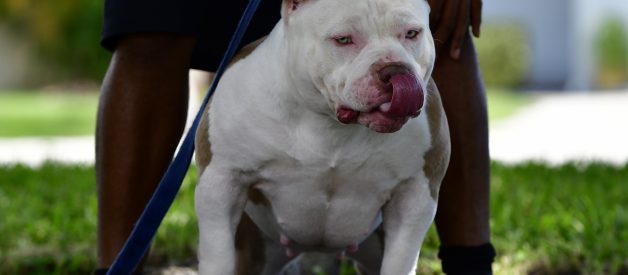PURCHASING BROOD STOCK, BASICS OF LINEBREEDING, INBREEDING & OUTCROSSING PLUS: BRACKETT?S FORMULA
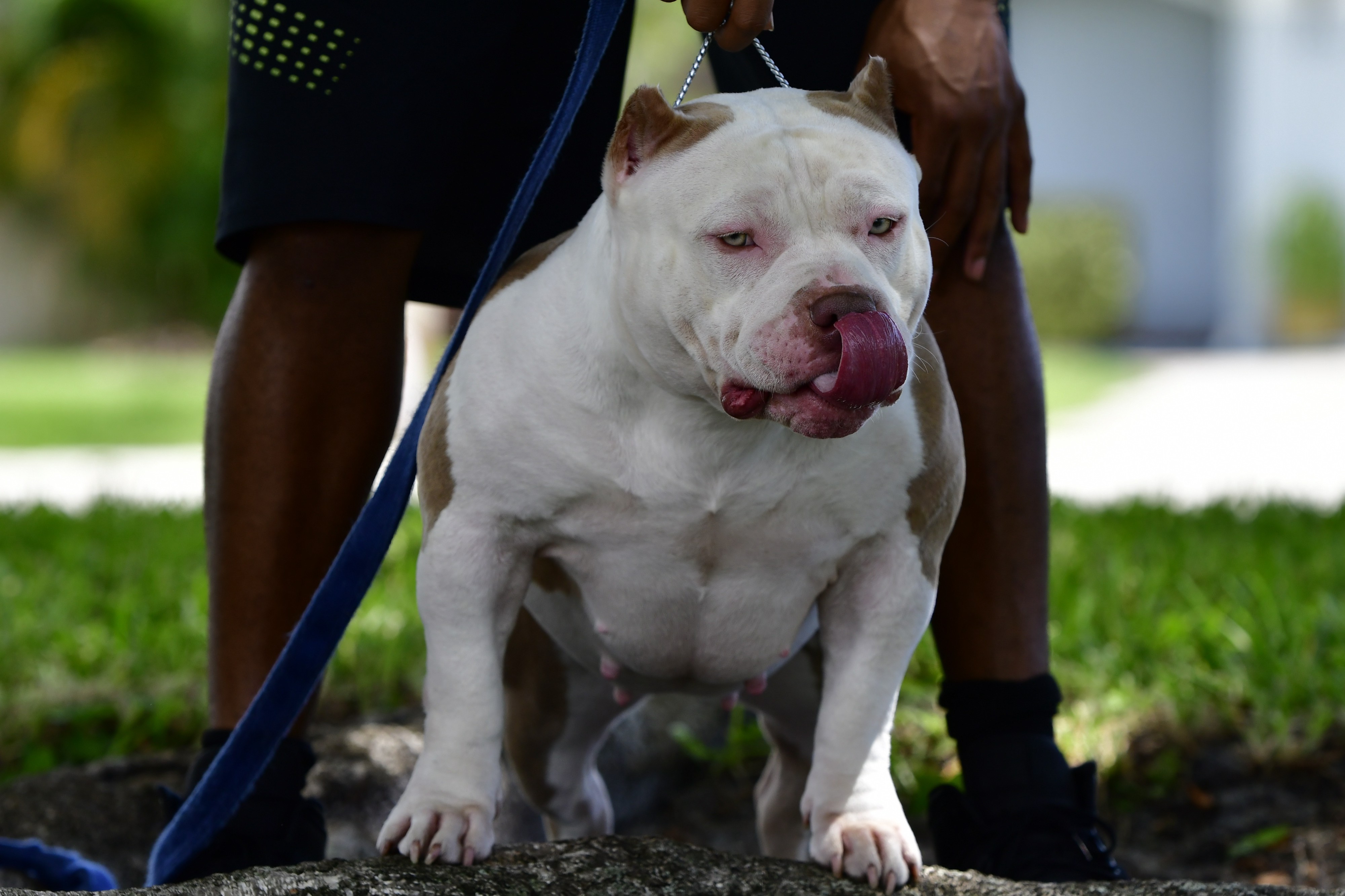 ABKC Pocket Champion Venomline?s LIL? TING (Venom X Moana)
ABKC Pocket Champion Venomline?s LIL? TING (Venom X Moana) ABKC Pocket Champion Dawghouse?s FURY (Venom X Sookie)
ABKC Pocket Champion Dawghouse?s FURY (Venom X Sookie)
How did this relatively new breed go from virtually unknown, to the top of lists for fastest growing dog breeds each of the past five years? First, let?s revisit how it all began.
See: Everything You Need To Know About The Fastest Growing Dog Breed: The American Bully
ORIGIN OF THE AMERICAN BULLY BREED
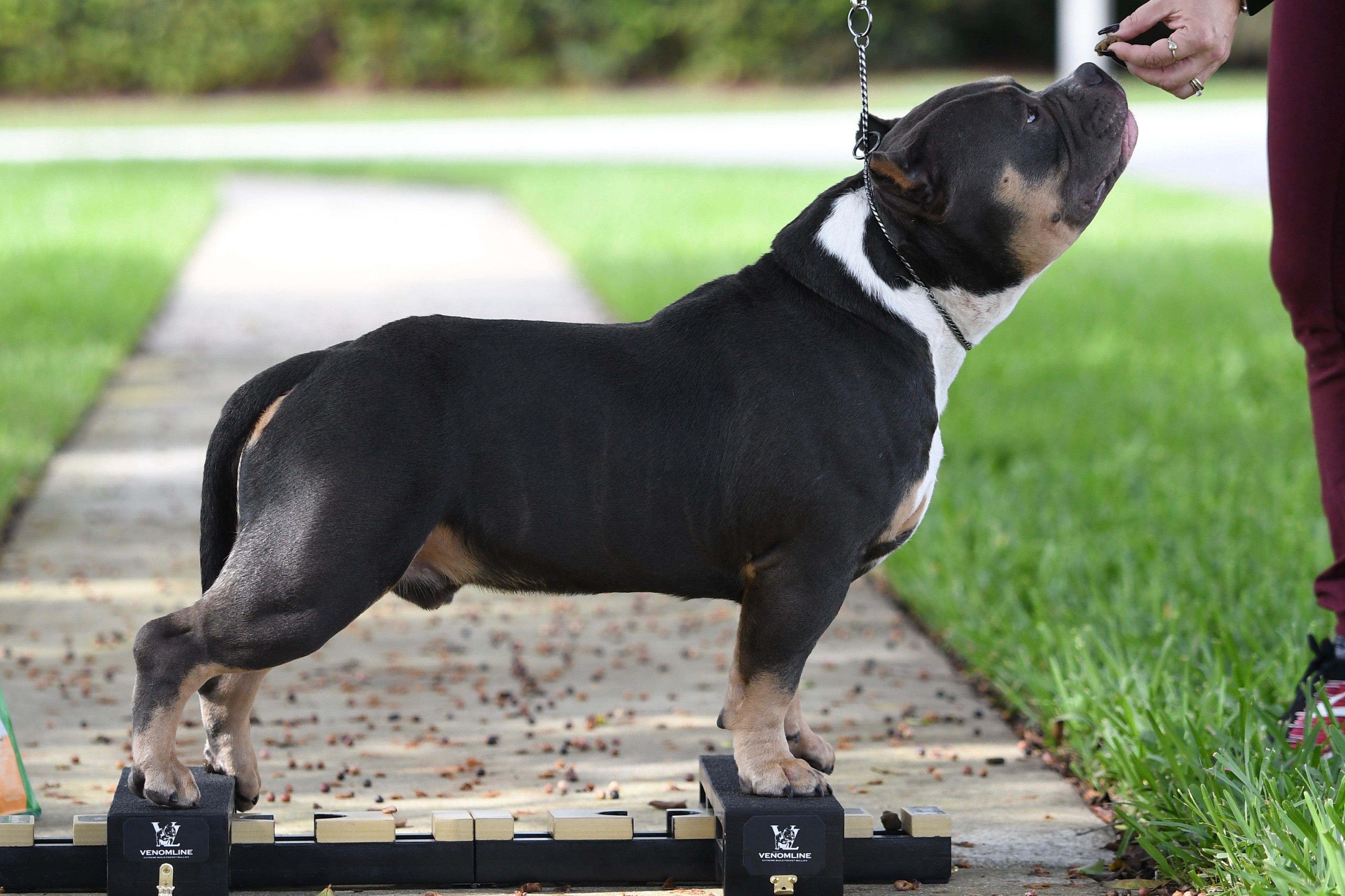 2020 BULLY KING Magazine Mascot BIG APACHE Owned by Dawghouse Bullies
2020 BULLY KING Magazine Mascot BIG APACHE Owned by Dawghouse Bullies
The American Bully breed was created around 1990 and gained recognition and establishment in 2004 with the inception of the American Bully Kennel Club, also known as the ABKC Registry.
The United Kennel Club or UKC recognized the American Bully breed in 2013. There are other registries, but for the purposes of this article we will mention the main few- which are the ABKC, BBCR. BRC Global and the UKC.
According to the ABKC- The American Bully breed has been selectively bred to give America?s breed, the American Pit Bull Terrier, a new direction and outlet. Like with the American Staffordshire Terrier (which is also an offshoot of the American Pit Bull Terrier) all of the positive characteristics of the breed?s ancestry were kept. These Include loyalty, stability with humans and children, along with many of their physical attributes. Traits of dog and human aggression have been bred out, as they have no future purpose for this trait (outside of hunting & sport) A reinvented breed was formed, with the purpose of being the ultimate companion breed, and this breed is the ?American Bully.?
According to the UKC- The American Bully breed was subtly influenced by the infusion of several other breeds, which include the American Bulldog, English Bulldog, Pacific Bulldog as well as the Olde English Bulldogge among other Bulldog breeds. What differentiates the American Bully breed from it?s ancestors- the American Staffordshire Terrier and the American Pit Bull Terrier (aside from it?s genetic makeup) is the dog?s physical appearance. The American Bully Breed is one of heavier bone structure and ?bullier? build than it?s American Pit Bull Terrier and Staffordshire Terrier ancestors, but without many of the health issues prevalent in many of the breed?s Bulldog ancestry.
Read: History Of The American Pit Bull Terrier & The Evolution Of The American Bully
 Top Pocket Bully Studs | Louis V Line?s Venom & Omega
Top Pocket Bully Studs | Louis V Line?s Venom & Omega
To many people, it?s the perfect blend, a breed without the game drive of a Pit Bull, yet more active and with less health issues than many of the Bulldog breeds in its makeup. The result: a calm, confident breed of dog with a statuesque build and the muscle of a bodybuilder. Despite the American Bully?s fierce and powerful appearance their demeanor is gentle, making the American Bully an excellent family companion.
The breed is known for having an affinity toward children (they love kids) and a surprising ability to pick up on the emotions of their owners. A breed with a fun and quirky personality, a zest for life and an exuberant will to please their family. They are friendly with strangers, other dogs and most other animals. Human or dog aggression, extreme shyness or viciousness is very uncharacteristic of the American Bully and is highly undesirable.
 Venomline?s Swizz as a puppy
Venomline?s Swizz as a puppy
EXPLOSION IN POPULARITY
The American Bully first became one of the fastest growing new breeds in 2014 and it has remained in the Top 5 every year since. In 2018, the American Bully breed became the fastest growing dog breed in terms of popularity and it hasn?t shown signs of slowing down since. The breed is on track to finish 2019 in similar fashion. So why are so many falling in love with this breed?
Even with the American Bully breed?s explosive growth and expansion into new countries and territories, there is still much confusion about the breed accompanied by several misconceptions and stereotypes. Inaccurate information online made worse by ill informed media have furthered misunderstanding regarding the breed. There are some who still confuse the American Bully with it?s cousin the American Pit Bull Terrier. But both are distinct and separate breeds, recognized by several respected registries as such.
So.. the American Bully breed has caught your eye, but there?s so many different types, bloodlines and classes to choose from that it can be a little overwhelming at first attempting to decide where to even begin. That?s ok, we?re here to help. For those new to the breed one of the first decisions to make is deciding on a class.
DECIDING ON A CLASS
This is one of the first and often overlooked steps when deciding to purchase an American Bully puppy or adult. Ask yourself, what size of bully best suits your interest? Do you want something smaller or shorter? In this case, you?ll probably want a Pocket. Like your dogs bigger? Then you probably want a Standard. If that?s not big enough for you and you?re wanting something over 100lbs and massive, then the XL class is probably for you.
There are four different classes in the American Bully. The difference between them is height (with the exception of Classic, which is simply the same height as the Standard Bully,, but carrying less mass) Once you?ve decided which size you prefer, next ask yourself what is your goal? Are you simply interested in a pet, or are you considering having a litter or showing in conformation events (dog shows)?
The answer to these questions will help you with where to begin your search and can also have a big effect on the price you will be paying. If you?re simply looking for a pet, you can find one for a much lower price than if you?re looking for a show dog or breeding stock. If you do plan to show or breed in the future, it often makes sense to pay for a higher quality dog than what you would be getting a pet prices.
AMERICAN BULLY CLASSES
For those who may be new to the breed and still learning, let?s take a look at the different Classes in the American Bully breed according to the founding registry- The American Bully Kennel Club, also known as the ABKC Registry as well as the United Kennel Club, referred to as the UKC.
AMERICAN BULLY CLASSES: AMERICAN BULLY KENNEL CLUB (ABKC)
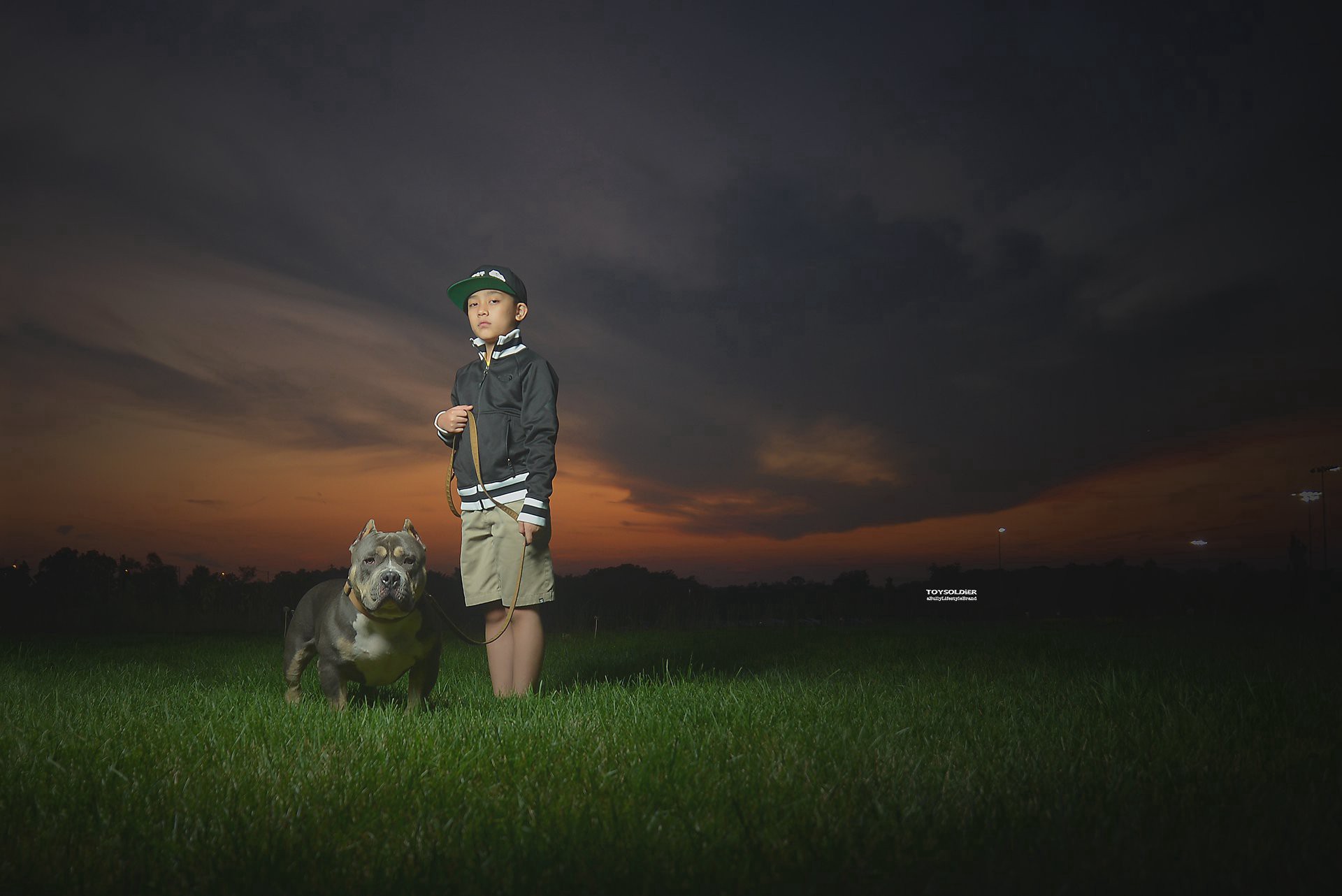
BREED STANDARD (ORIGINAL)
 ABKC Breed Standard (Original)
ABKC Breed Standard (Original)
It is important to note the ABKC got rid of the extreme class, initially a handicap So there are currently 4 Classes. The ?Extreme? which was the same as the standard overall, but carrying more mass. This variety was initially allowed some of what they refer to, as ?handicaps? meaning there was some leniency to certain traits beyond the standard.
This was because there was a huge amount of these dogs in the breed?s gene pool base and from a large bloodline within the breed; which was one of the founding bloodlines to be exact. The reason for the leniency is these were bigger heavier dogs that needed more time of development to achieve ideal conformation. The ?handicaps? were designed to be eliminated over time until this variety met the same standards as the Standard.
Standard and Pocket are now not to be penalized for dogs carrying more mass as long as they are correct and balanced.
ABKC AMERICAN CLASSES 2014-PRESENT

This is an amendment to the basic standard which a Pocket Bully is determined by its adult height.
Males under 17? and no less than 14? at the withers. Females under 16? and no less than 13? at the withers.
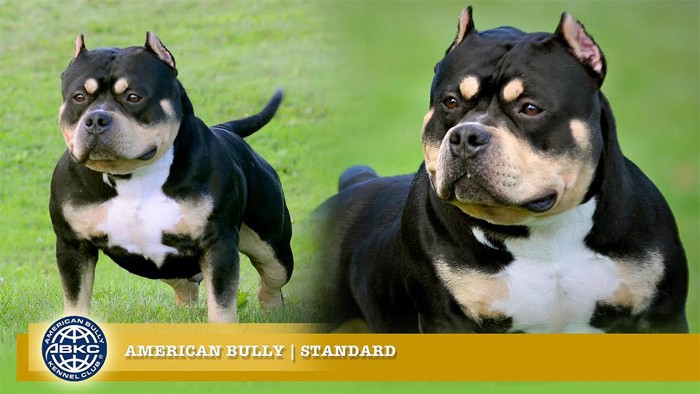
STANDARD
The American Bully should give the impression of great strength for it?s size. It is a compact and medium/large size dog with a muscular body and blocky head. The American Bully should have the appearance of heavy bone structure with a bulky build and look.
Males 17 inches ? 20 inches (43 cm ? 51 cm) at the withers. Females 16 inches ? 19 inches (40 cm ? 48 cm) at the withers.
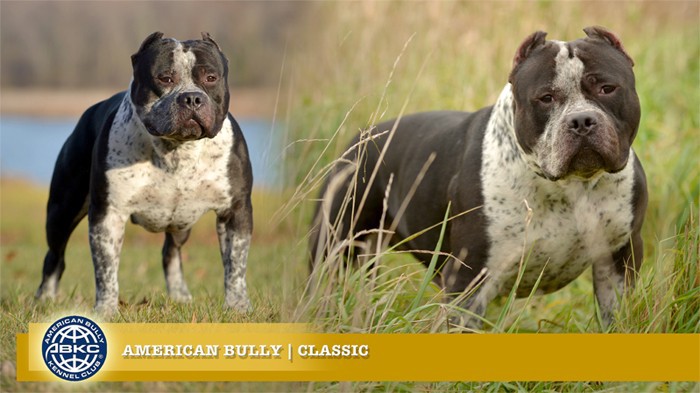
CLASSIC
This is an amendment to the basic standard. A Classic Bully is determined by it?s body structure and build. Both sex dogs with lighter body frames and less overall body mass, but still exibiting ?bully? traits.
Classic Bully variety is simply an American Bully dog having lighter body frames (lighter bone) and less overall body mass (less substance) than the Standard American Bully. Aside from this difference, the Classic Bully variety follows the same standard as the Standard American Bully.

XL
This is an amendment to the basic standard, determined by it?s adult height. It is important to note that the XL Bully variety is simply taller than the Standard American Bully. XL dogs share the same build, body type and breed type as the Standard American Bully.
Males over 20?-23? at the withers. Females over 19?-22? at the withers.
Now that you have a basic understanding of the different classes of the American Bully breed and that that a dog?s height (and sometimes build) determine what class they fit in, let?s move on to discuss important things to consider before having a litter for those considering having puppies.
Below we cover important things to consider before making the decision to have a litter or to become a breeder.
BEFORE EVEN CONSIDERING BECOMING AN AMERICAN BULLY BREEDER
Before making the commitment to become a breeder and establish your own bloodline, an honest appraisal of your resources is in order. First, do you have the money and time to invest in this endeavor? A large kennel facility is usually not necessary if you get two or three quality ?foundation? bitches to begin with. Do you have cash on hand for progesterone testing, artificial inseminations, emergency c-sections, vet bills, and proper care for the puppies? What if your breeding female becomes ill or develops an infection like pyometra? Do you have 3?5K saved in the event an emergency happens? The worst possible thing that you can do is make the decision to become a breeder, and then not being able to afford caring for your dogs in the event of an emergency.
More important than space and money is the commitment to the pups that you will be producing. For breeders to know if their breeding program is successful, ongoing evaluation of the pups is essential. Most of us do not have unlimited space, so placing pups in good homes where they will receive adequate care and nutrition, training and evaluation is going to be essential. Once you?ve done your homework, have your resources in order, decided on a class and have made the decision you?re willing to commit to everything required to responsibly breed dogs, you?re going to want to start by purchasing foundation stock.
PURCHASING ?FOUNDATION? DOGS
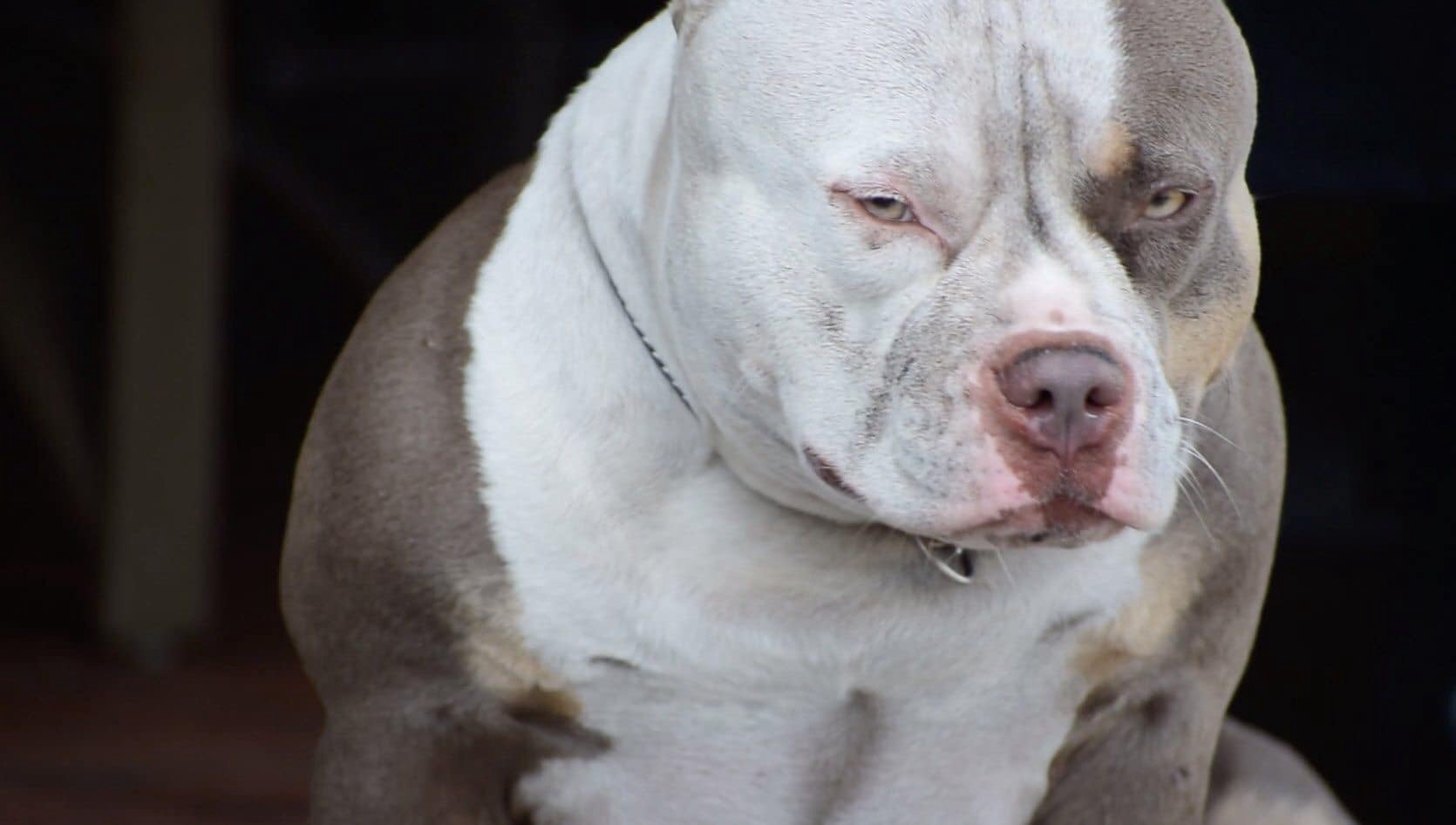 Venom daughter Khaleesi
Venom daughter Khaleesi
?First you will need to the right kennel to purchase from. Personally I started out with two males and a female, but that was not the best move. I wish someone had advised us to start with females!
Unfortunately I had to learn through trial and error, but to anyone reading this, you can save 3?4 years of time by listening to me on this one. If your goal is to become a breeder, you?re going to want to start with quality females. You?ll want to get your foundation females from a kennel that has been around for a while.?
– Venomline?s Matt Siebenthal
Be sure to get detailed pedigree information on the dogs to ensure you are getting a quality linebred dog (meaning that the same ancestors appear more than once in the 4 generation pedigree) Linebred dogs usually produce more consistent litters. Kennels that have been around for a while, that have quality productions and knows what they?re doing will usually linebreed.
There are a ton of overnight breeders hyping up their litters as the best thing since sliced bread, but most don?t have the productions to back up the hype. Has the breeder produced any Champions or Grand Champions? What Studs have they produced? Have the females that they?ve produced turn out to become quality breeding stock for other kennels? How do some of the later picks on their litters turn out?
This will say a lot about the consistency of a breeding program.
Once you have purchased foundation females to build your program with, the next step is to decide on a Stud.
DECIDING ON A STUD
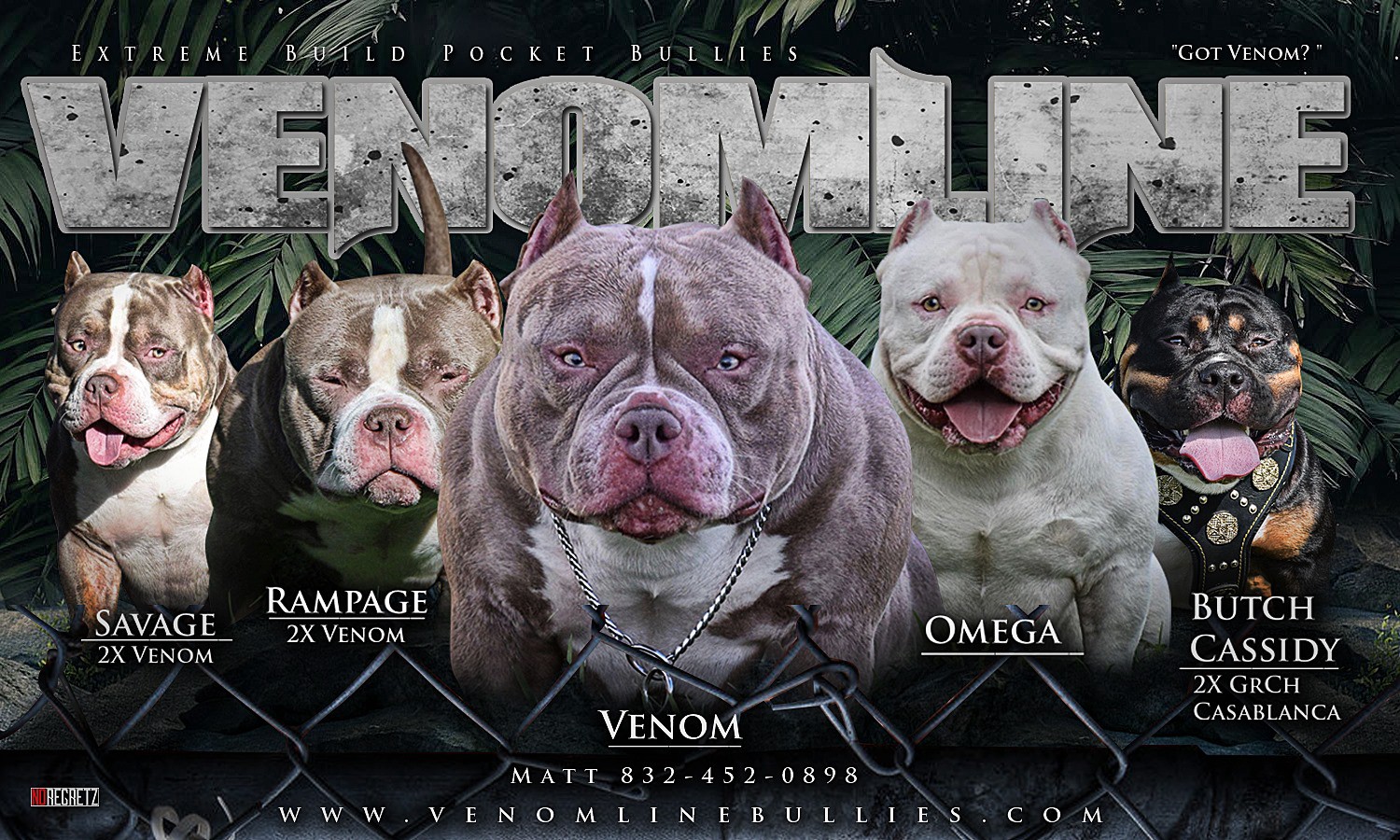
Most breeders offer a stud service. If you are new to breeding dogs, you should take advantage of this.
Many that get started in the dog breeding business usually purchase a stud dog or two along with some female dogs. As Venomline discussed above, the better way of going about this is to start off by purchasing female dogs.
When they are ready to be bred you can contact kennels that offer stud service or contact the kennel you purchased the female from for use of their Studs. Housing, feeding, and taking care of stud dogs is expensive and you?re not always guaranteed to have a great stud dog once they mature.
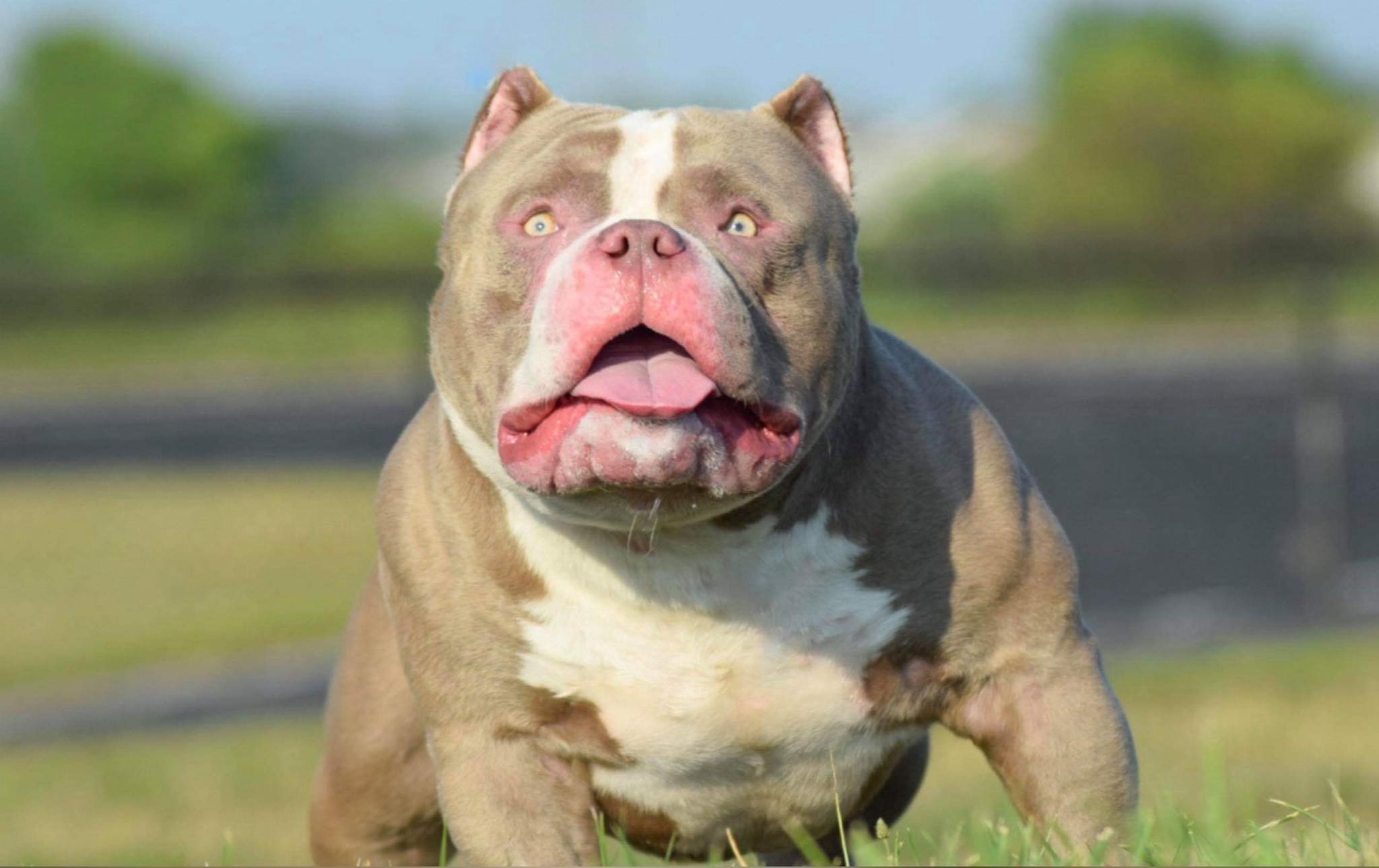
BENEFITS OF USING A STUD FROM ANOTHER BREEDER INSTEAD OF PURCHASING ONE YOURSELF:
1. Using a well known stud can help with litter sales
2. You can line breed your dog using the kennel that you purchased your female from. (Line breeding will produce more consistent litters)
3. You could end up waiting a year or two only to find out that the male that you purchased didn?t turn out to be a worthy stud dog. (Avoid this all together by using studs from a top breeder)

Many breeders will decide to breed their foundation female to a mediocre male (because that?s what they purchased) The outcome: usually a watered-down version of what was originally intended.
Doing this can set a breeder back several years, whereas ?grading up? (the breeding of females on hand to a male of higher quality) can be a shortcut to success.
A STUD VS A ?PROVEN? PRODUCER? THERE IS A DIFFERENCE
 Louis V Line?s Venom
Louis V Line?s Venom
Any male dog that produces semen has the ability to become a Stud. But, a Stud that is a ?Proven Producer? is one that can out produce themselves on a consistent basis. They are the few with the ability to stamp their look with every litter. Top producing dogs are most often inbred or linebred from an outstanding bloodline.
Inbreeding and linebreeding produces a prepotent dog whose genetic material is homozygous. Homozygous is a term that indicates that the gene pairs are the same. Since only one gene is inherited from each parent, if the parents are related, as in inbreeding and line breeding, the chance of doubling up the gene pair is greater than in the case of breeding unrelated dogs, or outcross breeding.
 Venomline?s Rampage
Venomline?s Rampage
The term prepotent means a dog that can produce offspring with his same characteristics. The reason is that a dog that is homozygous for a certain trait will pass this trait 100% of the time to their offspring.
A dog produced from an outcrossed breeding that is heterozygous (the gene pairs being different) for a certain trait, even though they themselves have the trait will pass the trait on to their offspring only 50% of the time.
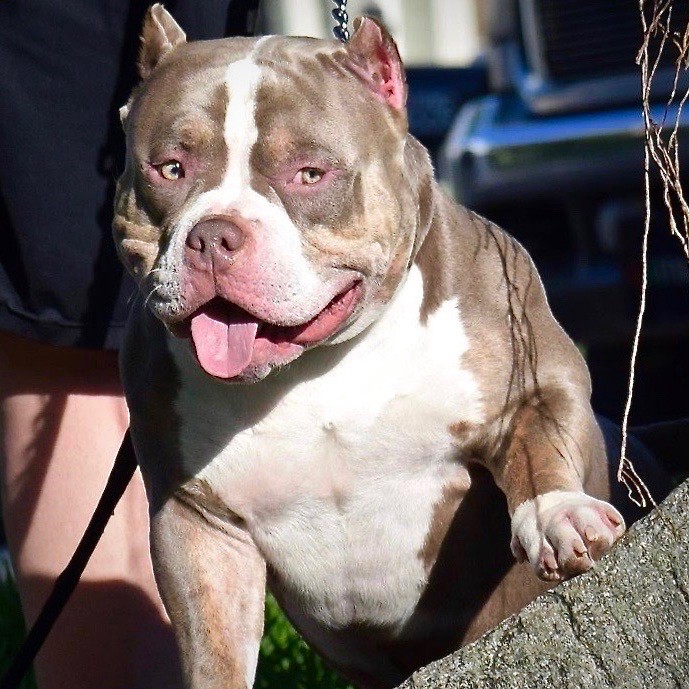 Venomline?s Savage
Venomline?s Savage
A breeding dog needs to be selected based on the dogs bloodline, the method of breeding that produced the dog (inbreeding or line breeding) as well as the individual attributes that the dog will bring to the breeding program.
Understanding these simple principles will help anyone who?s serious about becoming a Top Breeder pass up the competition, sometimes in just a few generations.
SHOW DOGS VS STUD DOGS
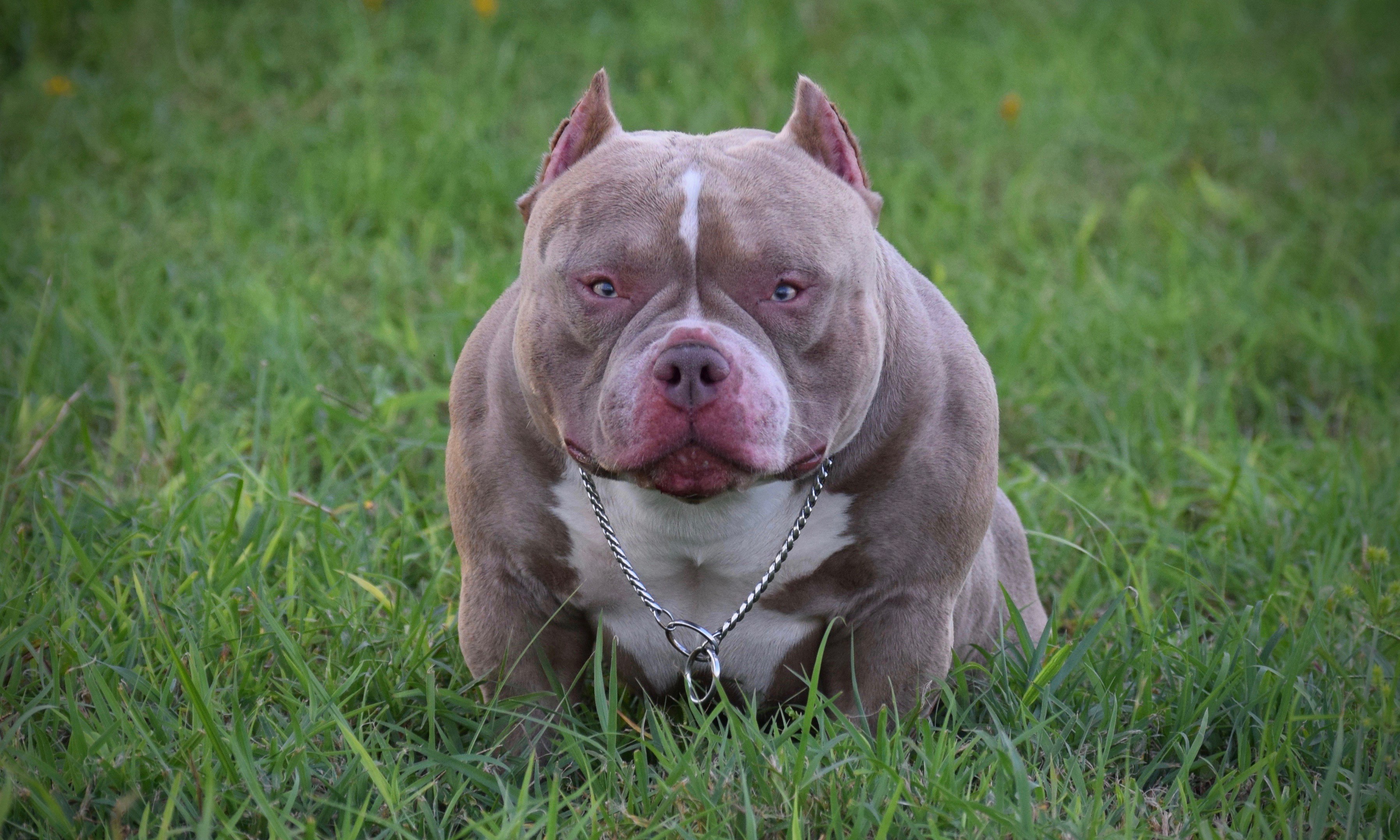
One of the biggest mistakes that breeders, novice or veteran, can make is to confuse their show dogs with their breeding dogs. They can be the same. We hope they will be the same. Often they are not.There are those who say show wins are the indicator of a dog?s value to the breed. In other words, if many judges agree a particular dog is the current ideal in its breed, the dog should be bred to. I agree ? but only to a degree.
?A dog can be a truly great show dog and a poor sire. A dog can hate the show ring and never win a point and be an outstanding sire. It is just as simple as that.?
You can get every judge in the country to agree that the dog of the hour is the dog of the hour, but that same dog can be a complete disappointment in the breeding department.
If a dog?s quality is not realized in the whelping box, all we have is a box full of ribbons and nothing more.
This is not to say a winning dog cannot also be an outstanding producer. Records prove otherwise. But I cannot stress strongly enough that it is the producing ability that must be looked to and not the show record! Even the outstanding show sire can be misused. Most breeds have had those truly wonderful show dogs who develop records that become the envy of one and all. Unfortunately, they become the envy of too many who feel if a dog is good enough to win every award in sight, it must be good enough to breed every female in sight.
In a way, the popular show dog that produces well only with certain female lines can be very destructive to a breed. A few excellent youngsters emerge from the right combination and the parade begins. Every female that can see lightning and hear thunder is bred to the dog, but the percentage of quality produced is minuscule. The breed takes a big step backward.
Truly great sires are really few and far between. There?s an old saying I heard somewhere along the way that goes something like, ?You can breed that one to a fence post and you?ll still get good pups.?
They are the rare ones, the ones that any breed is lucky to have, but it is highly doubtful that any breed will have such a dog any more than once in any breeder?s lifetime.
? Rick Beauchamp
Richard G. (Rick) Beauchamp is the Best Selling Author of Solving the Mysteries of Breed Type and Breeding Dogs for Dummies. He has judged all breeds throughout the world and was one of the United Kennel Club?s first all breed judges.
BECOMING A BREEDER
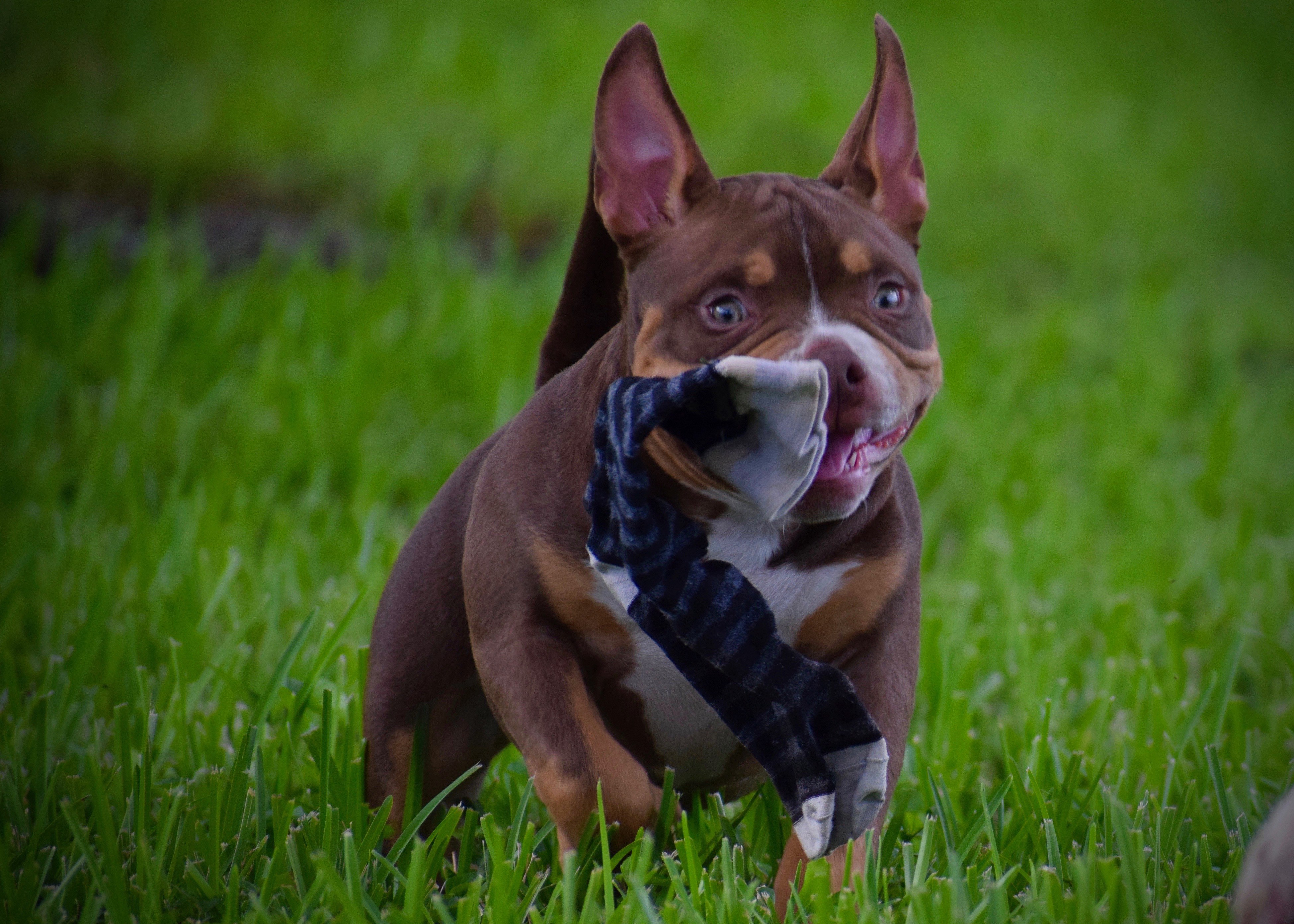
Now that you have a basic understanding of the importance of starting out with quality foundation females as brood stock, as well as the importance of selecting a Stud that?s proven as a Producer, the next step is to establish a breeding plan. Doing this alone will set you apart from the competition. Trust us when we tell you, they?re not doing this.
Breeding a litter of pups is not the same as becoming a breeder and developing a bloodline.
We have within our breed bloodlines that are known for producing great dogs as well as bloodlines that are known for producing mediocre dogs with certain problems, i.e. conformation faults, health issues, temperament faults etc.
The newcomer that is interested in developing a? bloodline? must understand that it is more that having your name carried as a part of the registered name of the dog. It is the development of a family of dogs that breed true for breed characteristics that you deem as essential and desirable, and that have been selectively bred into your family of dogs.
STEPS TO BECOMING A BREEDER
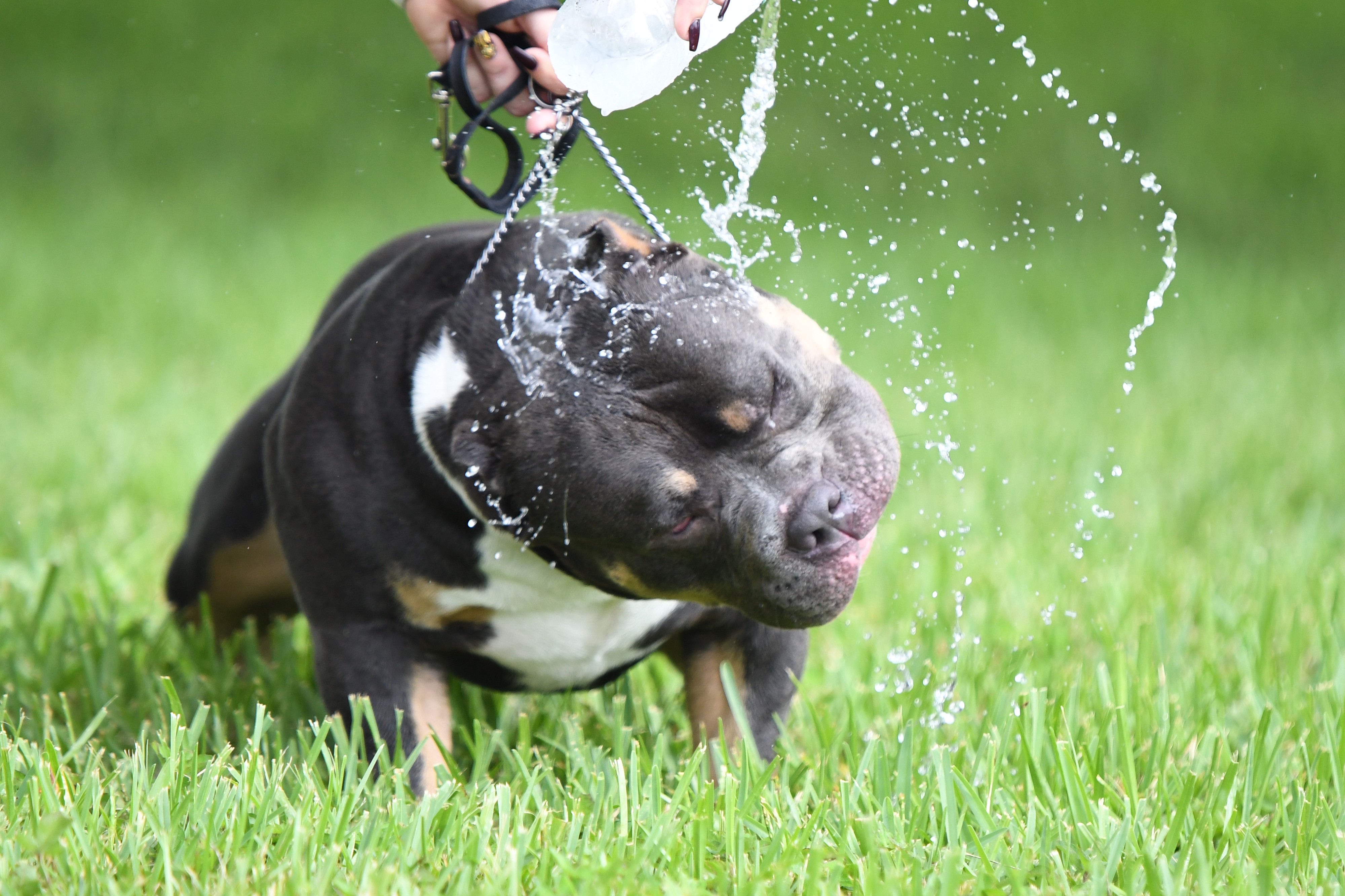
I. ESTABLISHING A BREEDING PLAN
A) Number one is to identify those breed characteristics that you want to see reproduced in the dogs that you will produce. Identifying your individual list of characteristics that you want to develop in your bloodline requires that you are familiar with the breed character and are knowledgeable about the breed standards that have been established. You will also need knowledge about structural soundness and genetic health issues within the breed.
B) To develop an eye for a dog, to be able to evaluate one dog from another in terms of those traits that you are breeding for.
II. SELECTION OF BROOD STOCK
Once a breeder has developed a breeding plan, an evaluation of the brood stock that you are going to be using is the next step. First and foremost, the individual stud dog or brood bitch must possess the outstanding traits that the breeder is looking for in the offspring. The mating of animals with similar characteristics tends to produce offspring that resemble themselves. This is known as like-to-like, type-to-type or positive assortive mating.
?Pedigrees are great, but they don?t mean jack if the two dogs being bred don?t carry the desired look/traits. Look at the dogs in front of you.?
– Double L?s Ty Lumley
It is obvious that breeders should avoid mating animals with the same faults, as this type of mating will also tend to produce offspring with those faults set within the family of dogs.
III. PEDIGREE ANALYSIS
An analysis of the dog?s pedigree is the third but equally important step that must be considered in the selection of brood stock. For novices, a dog?s pedigree is usually meaningless. For the experienced fancier, the pedigree is a profile of genetic potential, containing an unlimited amount of information. Knowledge about the individual dogs in the pedigree can be obtained firsthand from the dog?s breeder.
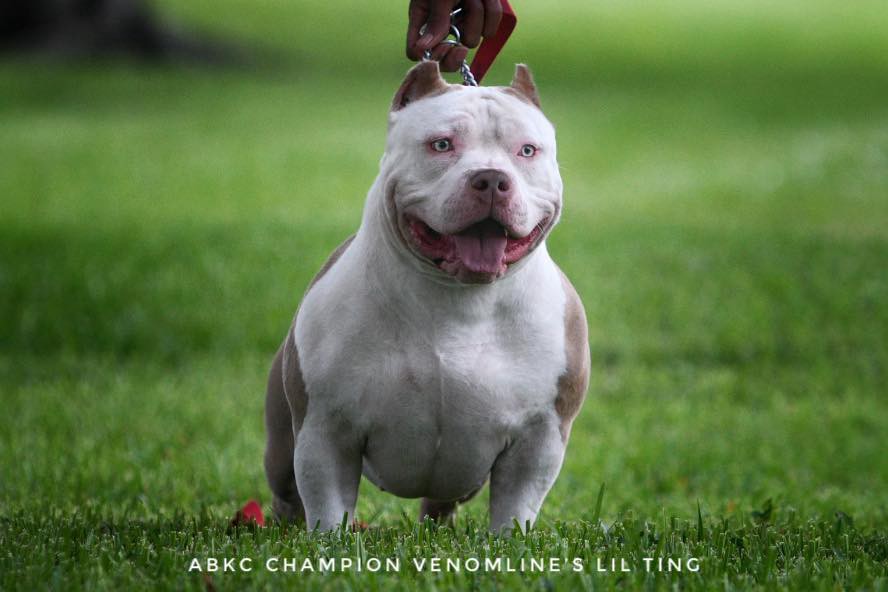
Pictures and information on the dogs can frequently be obtained from the numerous breed magazines and breeders websites. Conformation titles on the individual dogs can also be used in compiling your database of information on the dog?s pedigree. After a number of years into a person?s breeding program, the breeder will have first hand knowledge of the dogs making up the pedigree of the breeding stock.
Also a database of information concerning the littermates as well as offspring from repeat breedings should be available to the breeder. This first hand information will always be the most reliable if the breeder remains objective. You can find the offspring a dog has produced in online pedigree databases such as Bullypedia and BullyPedex.
?You will want to become familiar with these. You?re going to want to add your own productions once you start having them. But perhaps more importantly, you can research which breeding pairs and bloodlines produced top dogs. There is almost unlimited information at people?s fingertips, but most are too damn lazy to use it.?
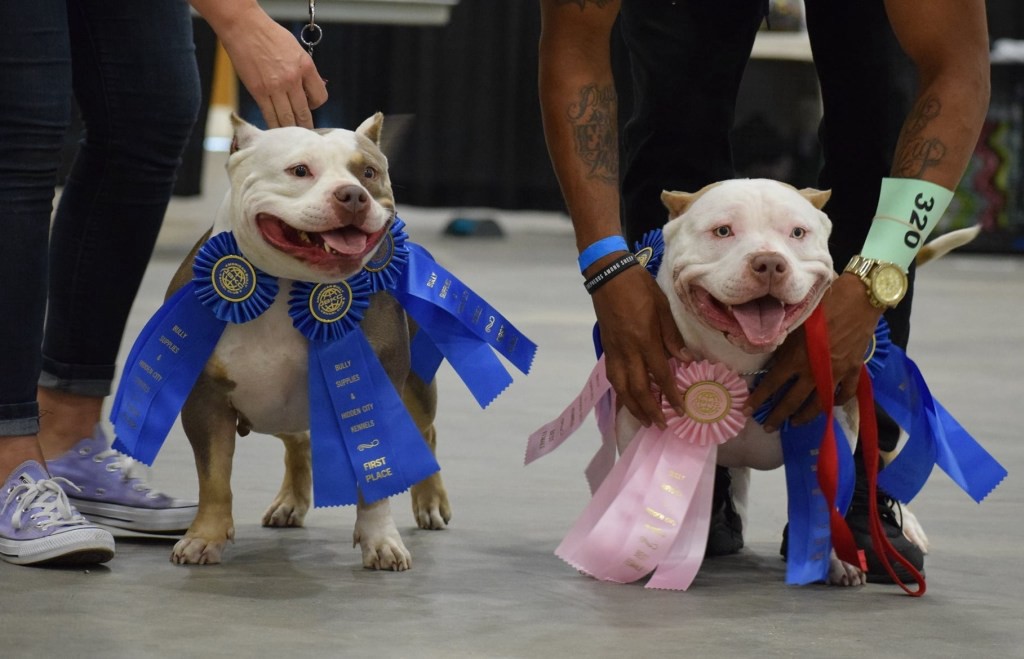
Attendance at shows, discussions with successful breeders and talking to judges and exhibitors about the breed can also enhance ones understanding. A study of the literature available about the breed and about dogs, genetics and breeding in general is also essential. The breeding of fine dogs is an art, with a strong scientific basis.
What a breeder seeks to produce, the ideal that he formulates, is his or her self expression ? the fulfillment of the creative urge. That lies the joy of breeding dogs. The emphasis a breeder places upon soundness, a great head, correct fronts or backend declares his own nature.
The breeder who would achieve a consistent color or size at the cost of breed type or honest structure is a different kind of person from one who prefers a correctly made dog.
Read that again out loud.
All quality bloodlines have been established by incorporating quality brood stock from someone else?s bloodline. It is not often that you will be able to incorporate a pet quality bitch or dog into your breeding program and expect to produce consistent quality pups.
THE FATHER OF MODERN GENETICS AND THE MAN WHO APPLIED IT TO ANIMAL BREEDING
Although Gregor Mendel is the father of modern genetics, Jay Lush is the fellow who brought genetics to animal breeding. Lush was a student of Sewall Wright, who devised the coefficient of inbreeding, and a background in both genetics and mathematics allowed him to develop animal breeding into a quantitative science. Perhaps his most important contribution is a book first published in 1937 called Animal Breeding Plans, in which he laid the foundations on which the scientific breeding of both animals and plants still rest today. While parts are necessarily outdated now, much of what he wrote is as useful today as it was then.
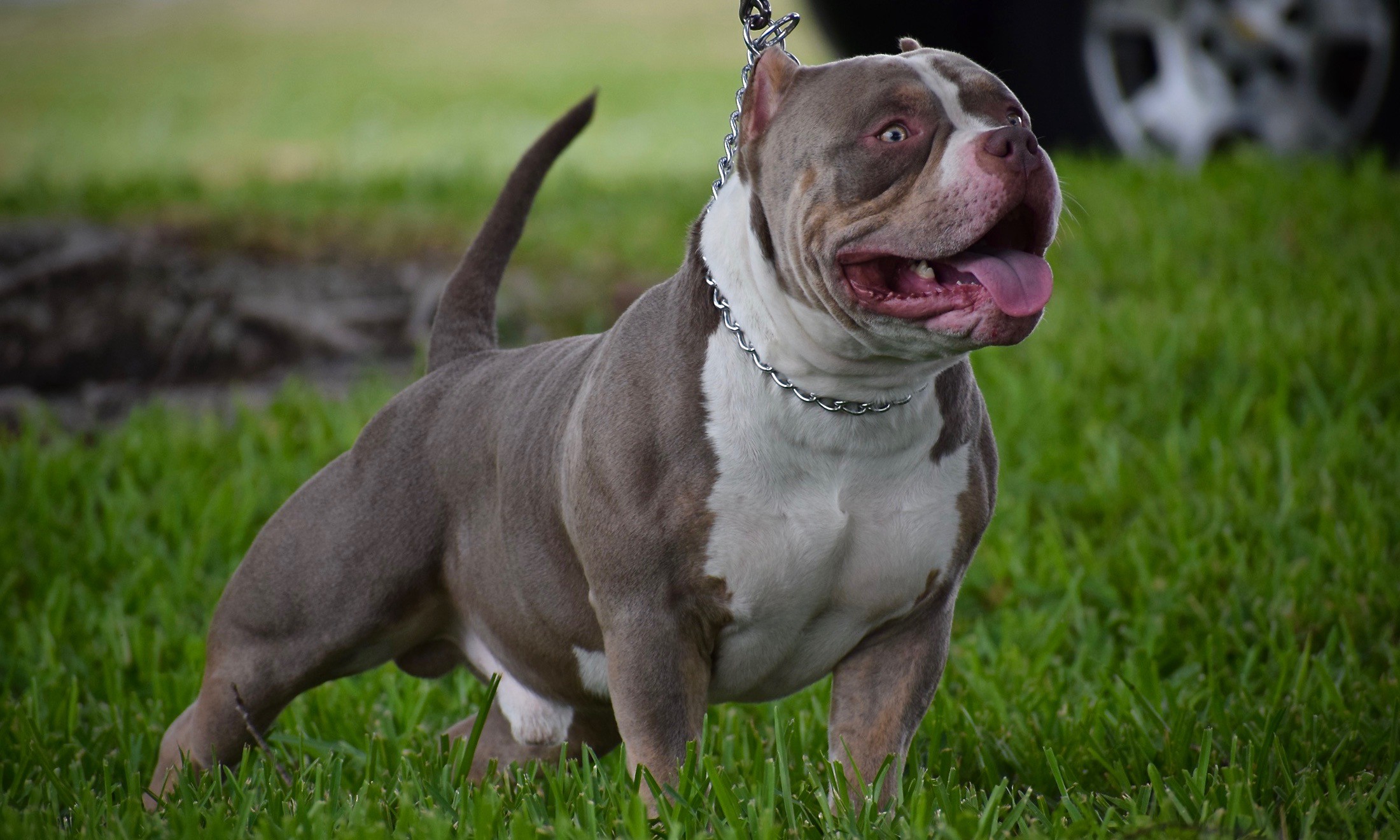 2X Venom | Venomline?s Savage
2X Venom | Venomline?s Savage
Most breeders know about inbreeding and linebreeding but find it difficult to clearly distinguish between them. Usually inbreeding is considered to be breeding among first-order relatives (e.g., sibling to sibling, parent to offspring), and linebreeding is a fuzzy version of ?not as close as inbreeding?. When Lush discusses linebreeding in his book, though, he clearly distinguishes between linebreeding and what he calls ?other forms of inbreeding?, which he simply defines as breeding between relatives.
For every generation that passes between the ancestor and the present, its influence is reduced by half. To avoid this progressive dilution, ?linebreeding takes advantage of the laws of probability as they affect Mendelian inheritance to hold the expected amount of inheritance from an admired ancestor at a nearly constant level. ?Linebreeding provides, so to speak, a ratchet mechanism for holding any gains already made by selection, while attempting to make further gains.?
CARRYING THE TORCH
Any time that a significant advancement in any field is made (especially science) it is often left at the feet of the next generation. Equally important are the ones who pick up the torch and expand upon the point where the previous generation?s research left off.
By the early 1950?s, Lloyd C. Brackett had become a legend in his own time. In part because of the quality of the dogs he produced and in part because of his candor when addressing problems related to the breeding of canines. He had much to say about the selection of sires, how to correct problems and how to make improvements. Brackett was considered one of the fathers of the German Shepherd breed in the United States.
At the time of his death he was the oldest living continuos fancier of the breed (since 1912). His kennel was called Long Worth and he is remembered throughout the dog world for his theories about breeding methods. Brackett was well read and a quick learner. Through his writings he shed light on the confusion and misunderstandings associated with line and inbreeding. One of his greatest achievements was to have produced over 90 champions in twelve years.

All of his methods and ideas were not new. For example, he combined the study of pedigrees with the results they produced. After years of watching what combinations produced the better offspring he refined his ideas about how to select breeding partners.
Out of these experiences came a formula that later he would make him famous. The formula was not new but his ideas about how to use it attracted attention. Breeders of domestic animals had used it for years. It relied on the principles of line and inbreeding. But it was Brackett and his approach to planned breedings that made it well known.
Brackett believed in pedigree analysis, litter evaluation, the use of line and inbreeding and a record system that was easy to use. Those ideas are what set him apart from others who did little more than practice the art of breeding. While Brackett is best known for his emphasis on the use of linebreeding he was not afraid to inbreed if the situation dictated it. Brackett believed that it made no sense to go forward with breeding before the needed information about the sire and dam had been collected. He placed great emphasis on health, temperament and breed characteristics. His planned breedings were based on the results that occurred in his pups. In other words, he learned from his mistakes.
Brackett understood the value of using quality dogs that were related to each other. This approach allowed him to concentrate the genes needed to produce desired traits. His techniques for reducing error and improving quality focused on the careful selection of breeding partners. They were central to maintaining and improving specific traits while at the same time reducing disease and other unwanted problems. Brackett became famous for breeding quality dogs with consistent type. His strategy relied on a series of breedings using relatives. Often times he was quoted as saying, ?never outcross when things seem to be going well, do it only as an experiment or when some fault or faults cannot be eliminated?.
He was careful to study each stud dog and their offspring, eliminating those who did not measure up and those who produced faults. Close inspection of his pedigrees show that many of his sires were themselves inbred or line bred and most were usually related in some way to the bitches in his breeding program.
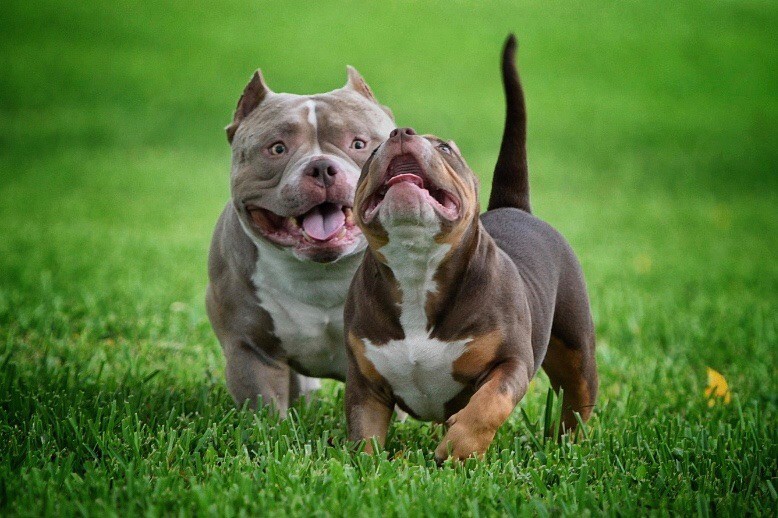
Brackett?s success helped to make line breeding popular. He demonstrated how to make improvements by retaining a common pool of genes through the use of related dogs. He believed that out-crossing was the least desirable method because it introduced new genes into his pedigrees, which in turn produced differences and genetic variations among the offspring.
It has been well documented that two full-brothers usually do not have the same genetic potential even though they both come from the same two parents. One sibling might inherit one set of genes from his father and the other might get a different set from an uncle through his mother. While each pup always receives half of its genes from the sire and half from the dam it does not mean that they each will get the same set of genes. This explains why littermates do not always look alike or have the same capacity to produce quality. Brackett kept detailed records on the differences between siblings. He was well read on this subject and occasionally mentioned the works of Aristotle and Mendel in his articles. In practice they all shared similar beliefs.
Brackett was concerned about the future of breeding better dogs and the lack of breeder education programs. He believed that ?the majority of dog breeders formulate no breeding plan and seldom if ever, when mating, consider how they will mate any of the resultant produced offspring.?
BRACKETT?S FORMULA
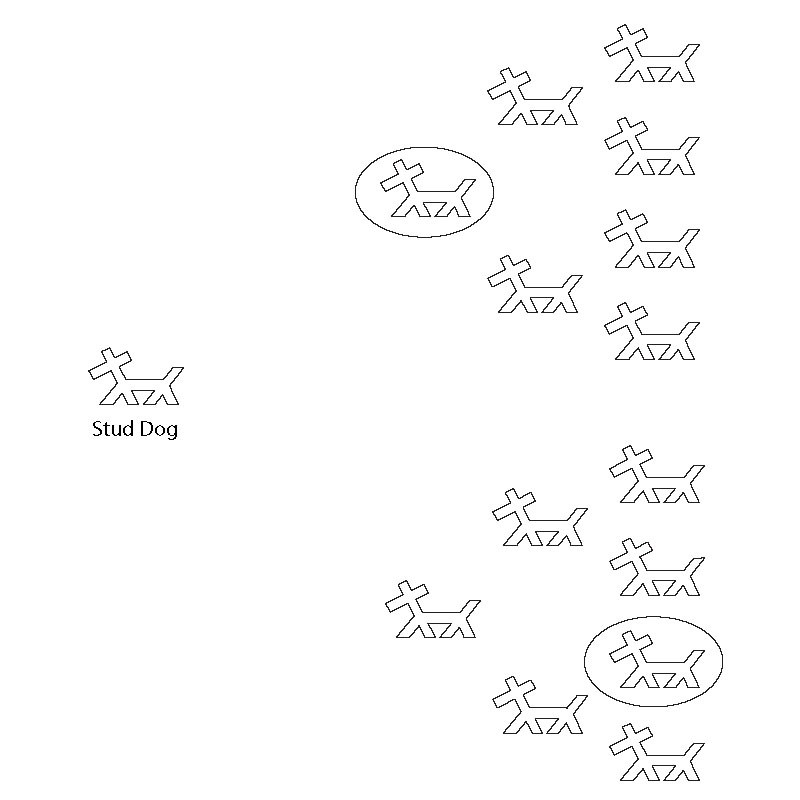 Figure 1 Pedigree of a Brackett Stud Dog
Figure 1 Pedigree of a Brackett Stud Dog
The formula Brackett preferred concentrated genes in a pedigree. He did this by placing emphasis on the sire of the sire.
In Figure 1, notice that the same dog appears on the sire and the dam?s side of the pedigree. Brackett liked to use one important dog and have it appear twice in a three-generation pedigree.
The basic formula he preferred can be stated as follows, ?Let the sire of the sire become the grand sire on the dam?s side?. Said another way, ?let the father?s father become the mothers grandfather?.
BRACKETT?S FORMULA APPLIED: A REAL LIFE EXAMPLE

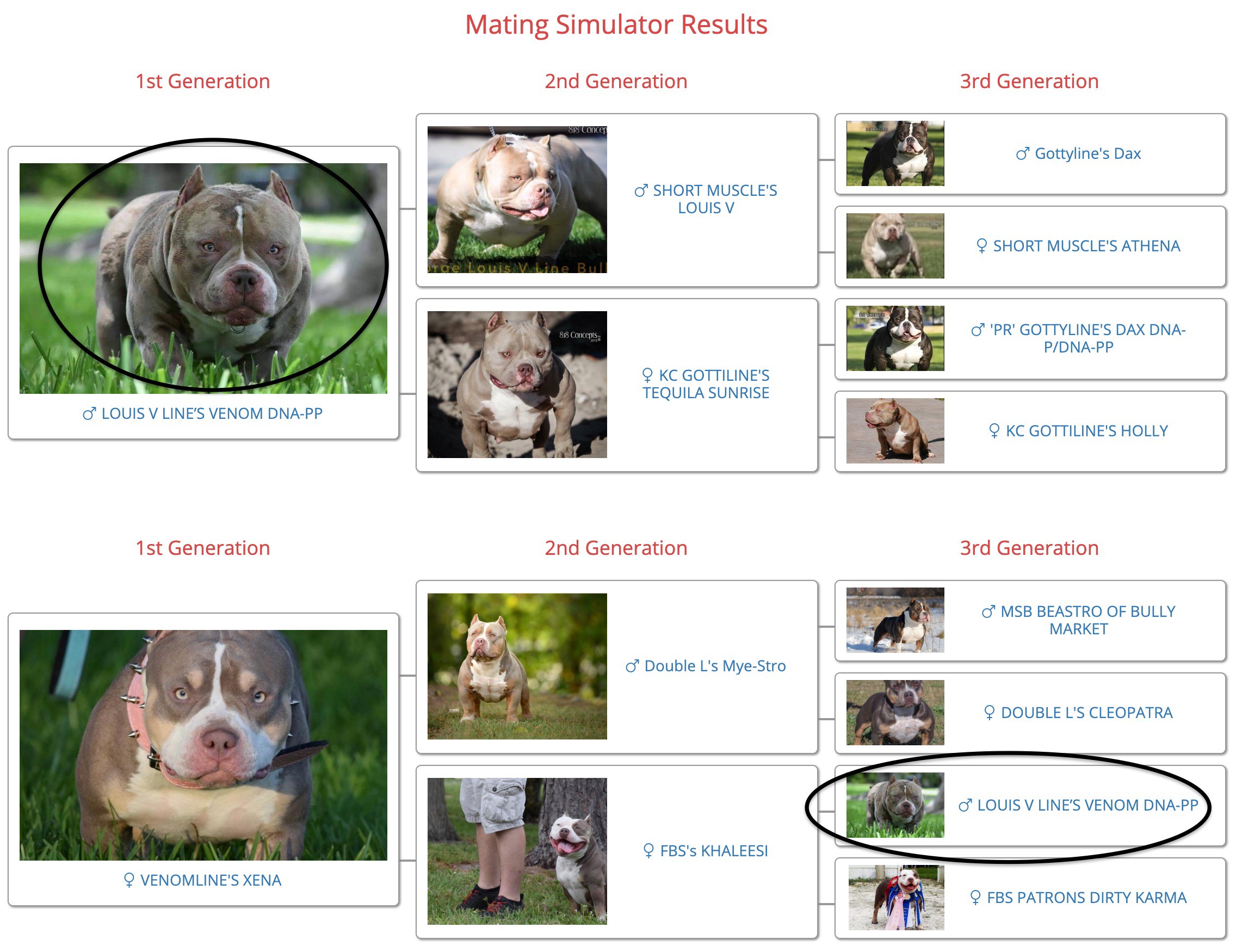
According to Brackett?s formula, which we are using in this particular example, males from this breeding would have ideal pedigrees with potential as Studs in Brackett?s program. Obviously we don?t breed solely according to Brackett?s formula, but it is one of the advanced breeding techniques that has proven successful for many breeders in a number of different breeds over the years. There are many other advanced breeding techniques and methods that we will cover in future articles.
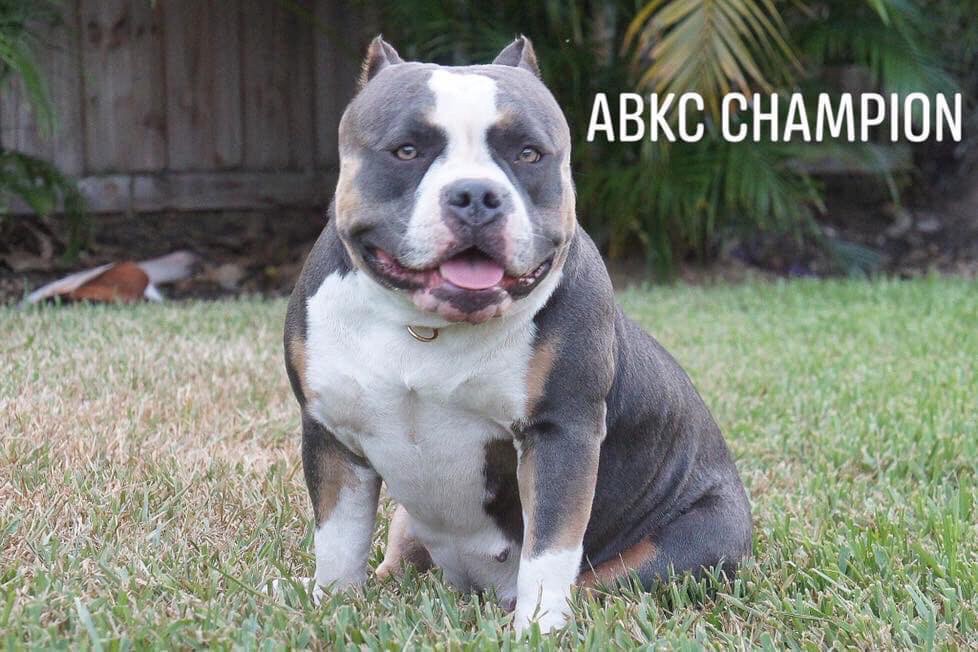
If you ever wonder how some kennels seem to always produce top quality dogs and consistent litters, while others can take a great dog from a great line and run it to shit in just a few short years, the answer is usually pretty simple. 99% of breeders (especially in the American Bully breed) don?t do any research, have no understanding of basic genetics, couldn?t name a single breeding technique and have no breeding plan. Their gameplan: breed two dogs that ?look cool? together.
Most have not put in the work to hone their craft. Yet they will be surprised and upset when they don?t end up with your results.
You can pass up the competition in just a few short years by dedicating the time and energy to study up on those who have had success and by applying those techniques to your breeding plan.
You don?t have to be a rocket scientist either. I?m not. Far from it. But you have a small supercomputer with unlimited information in your pocket. Quit being lazy and Google some shit. Respectfully, of course.
TYPES OF BREEDING
We have covered the basics of linebreeding, inbreeding, outcrossing, backbreeding and grading up in previous articles. In our next article, we will weigh the benefits and risks of each as well as going into further detail on each as well and also when an outcross should definitely be considered.
I. LINEBREEDING
II. INBREEDING
III. OUTCROSSING
IV. BACKBREEDING
V. GRADING UP
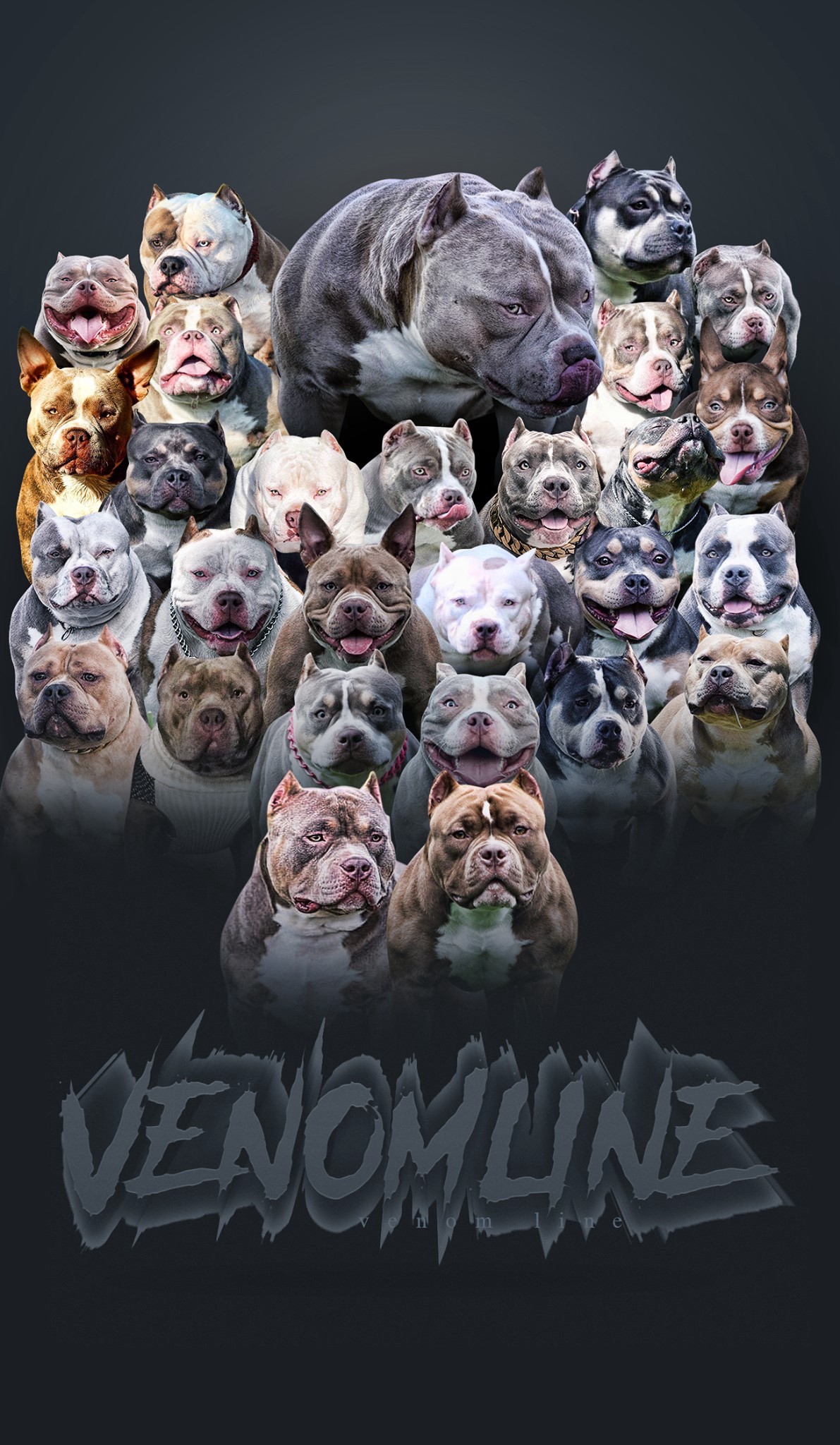
VENOMLINE POCKET BULLIES
- ABOUT
- FOR SALE
- BREEDINGS
- STUD SERVICE
- STUDS
- FEMALES
- PRODUCED
- NEWS
- VIDEO
